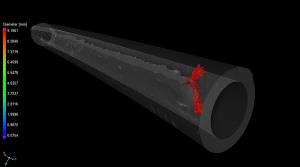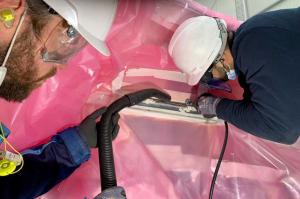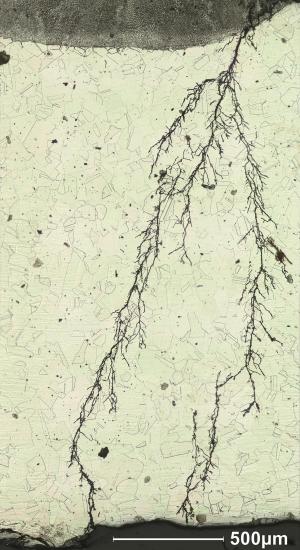Finding infinitesimal needles in a haystack
A cutting-edge X-ray process confirms microscopic cracking and keeps ITER on track to succeed.
And while the question seemed straightforward, finding the answer required a remarkable collaboration with the CERN particle physics laboratory using innovative X-ray tomography and advanced microscopy technologies that allowed scientists to measure cracks so small they had never been measured before.
"It was a complete first to use this kind of X-ray tomography to characterize a leak path of this magnitude," says Robert Pearce, the Vacuum System Project Leader. "We were able to identify micron level cracks that could have completely disabled the machine if they were allowed to grow over time."
By now, the saga of the cracks in ITER's thermal shield system has been well reported. In July 2020, routine helium tests detected a pinhole leak in a thermal shield cooling pipe on vacuum vessel sector #6 that was likely caused by a welding issue. This discovery prompted an examination of more than 300 thermal shield panels and in 2021 additional helium testing revealed three more, much smaller, leaks. The source of the leaks was hypothesized to be stress corrosion cracking from chlorides that had been trapped in the piping during the silver-plating process. Corrosion of stainless steel is rare, but examples can be seen when stainless-steel jewelry is tarnished in chlorine swimming pools and there are even extreme cases of stress corrosion cracking resulting in pool roofs collapsing when stainless-steel beams suffer prolonged exposure to chlorine.
However, the fact that the leaks were thought to be caused by stress corrosion cracking was deeply troubling. If this hypothesis was true, it meant corrosion was likely occurring and progressing elsewhere in the thermal shield piping and could lead to hundreds or thousands of additional leaks in years to come.
It was thus crucial to find out if there was widespread corrosion-induced cracking that would lead to other leaks in the thermal shields cooling pipes. But there was just one problem: no existing techniques could assess such minuscule cracks.
To solve this problem, the ITER vacuum group turned to the Mechanical and Materials Engineering team at CERN, the European Organisation for Nuclear Research. ITER has had a Cooperation Agreement in place with CERN since 2008 to draw on the expertise in material assessment and magnets that was developed during the construction of the Large Hadron Collider.
The first step was to analyze the material in the spots where ITER's helium testing expertise had accurately pinpointed leak positions. Because there was no in situ technique for this, sections of the pipe were removed and sent to CERN. Pieces were placed in an X-ray tomography machine, where they were rotated and scanned for approximately six hours. The resulting scans offered initial 3D images of the route of the leak, which provided a precise location for accurate local scans and a fuller metallurgical inspection. Thin slices of pipe were taken from the location where the leak path was seen and then polished. This approach provided a tenfold increase in resolution compared to existing procedures and suddenly, the leak and the chloride-caused cracking were fully visible. It was the first known characterization of the path of a corrosion-induced vacuum leak in the 10-6 to 10-7 Pascal cubic-metre-per-second range, which corresponds approximately to a leak that would fill a birthday-party helium balloon in 30 years.
Having established the technology to visualize the cracking, the second stage began. In the summer of 2022, sections of the 14-millimetre-in-diameter, 2-millimetre-thick pipe were removed from what were called "regions of interest" on the thermal shield that were selected because of visible corrosion spots. Again, pipe sections were sent to CERN where they were sliced, polished, and X-ray tomographed. The images clearly revealed sub-surface granular and transgranular cracking that had started penetrating a quarter of the way through the pipes.
"It was quite unprecedented. We were looking at the cross-section and we could see typical lightning bolt structure that was like what you would see in a summer storm and evidence of chemicals that caused it," says Stefano Sgobba, the engineer in charge of the Materials team of CERN who oversaw the testing. "These advanced tools gave us a much deeper understanding of the process and the chronology of events."
With stress corrosion cracking confirmed on the very first piece of pipe analyzed by this combination of techniques, it was safe to conclude it was happening throughout the thermal shield cooling system. And although there wasn't immediate leaking everywhere, stress corrosion cracking can grow by between 0.1 mm to 10 mm per year depending on the conditions. By the time fusion would be ignited at ITER, the cracking could have led to thousands of leaks and the tokamak could have stopped functioning.
The existing 20 kilometres of thermal shield piping at ITER have now been declared unusable and a repair/replacement strategy has been designed for the vacuum vessel thermal shield, with a more resistant grade of stainless steel and the forgoing of the silver-plating process in future welded constructions to avoid any chance of residual chlorides.The joint ITER-CERN research into the stress corrosion cracking was presented at the 2023 IEEE Symposium on Fusion Engineering (SOFE) and the 28th International Conference on Magnet Technology (MT-28), while the new tomography process will be the subject of an academic paper, all of which will help shape guidelines for the construction of future fusion devices. Meanwhile at ITER, with a potential mission failure averted, the project forges ahead.
"We've got repairs to make, but it's still positive," says Robert Pearce. "ITER isn't unrepairable, the body of knowledge has been expanded, and we're in the solution phase."




